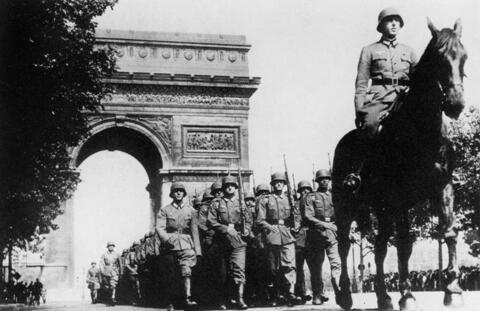The Battle for Western Europe
At a Glance
Language
English — USSubject
- History
- The Holocaust
Questions of Complicity: France and the Nazi Occupation
Although Nazi plans to create a thousand-year Reich were centered on the conquest of “living space” to Germany’s east, Hitler knew that countries in western Europe might stand in his way. He was especially concerned about France, which bordered Germany and could force it to fight on western and eastern fronts simultaneously. Assuming that France would go to great lengths to prevent Germany from becoming too big and powerful, the Nazis decided that they must defeat the French before pushing farther eastward from Poland. 1
They had other reasons for this decision. Germany had a history of military conflict with France, and the Nazis detested the French political ideals of equality and liberty. Nazi leaders also resented the presence of soldiers from African colonies in the French military forces and saw them as a threat to European racial purity. 2
France and Britain responded to the invasion of Poland by declaring war on Germany on September 3, 1939. But they did not engage in a major battle with Germany until spring 1940, when the French, especially, found little success in halting the German advance in western Europe. Bolstered by a powerful air force and a new tactic, the Blitzkrieg (“lightning war”), in which ground forces broke through enemy lines with rapid and overwhelming force, Germany conquered much of western Europe in a few months. In April 1940, the Nazis invaded the neutral countries of Denmark and Norway in order to protect their supply of steel and other resources from Scandinavia. Then, in May, Germany invaded the Netherlands. By May 17, the Germans had overrun that nation and half of Belgium, and they were fighting their way to France. On June 14, the Germans captured Paris, and the French military was on the verge of defeat.
On June 22, France and Germany signed an armistice agreement in the same railroad car in the middle of France’s Compiègne Forest where the World War I armistice of November 11, 1918, had been signed. (In fact, at Hitler’s request, German soldiers brought the rail car from a local museum to the forest so that it could be used at the ceremony.) The armistice divided France into two zones. One zone, which included northern France and an area along the Atlantic Ocean, was occupied by the German military; the other zone, which included most of southern France, remained unoccupied. According to the terms of the armistice, a French government based in the southern town of Vichy and headed by Marshal Henri-Philippe Pétain, an 83-year-old French war hero, and Pierre Laval, a French politician, would govern France. While the Vichy government governed autonomously in the unoccupied zone, its power was subordinate to German military commanders in the occupied zone. The Nazis put in place a variety of arrangements to govern the other western European countries it defeated. Some, like the Netherlands, were governed by a Nazi-appointed civilian governor, while others, like Belgium, were governed by the German military.
After the conquest of France, Hitler turned his attention to Britain, which possessed a powerful navy and an empire spanning the globe. At first Germany offered peace. Recalling Hitler’s previous false promises of peace, Prime Minister Winston Churchill, who had succeeded Neville Chamberlain two months earlier, did not accept Hitler’s offer. The Battle of Britain began in July 1940 with massive German air attacks designed to wipe out the British air force and expose its naval fleet. Every day for the next two months, hundreds of planes fought in the skies over Britain. Despite their best efforts, the Germans were unable to defeat the British, partly because the British did not fight alone. They had the support of Australia, New Zealand, and Canada, as well as South Africa and other parts of their empire. In fact, if Britain had fallen to the Germans, the British government had made arrangements to continue the war from Canada. The British were also aided by refugees from German-occupied Europe. Poland, France, Norway, the Netherlands, and Czechoslovakia were among the occupied nations that set up governments-in-exile in Britain—each determined to carry on the struggle to the end.
- 1Gerhard L. Weinberg, Germany, Hitler, and World War II: Essays in Modern German and World History (Cambridge: Cambridge University Press, 1996), 43.
- 2Gerhard L. Weinberg, Germany, Hitler, and World War II: Essays in Modern German and World History (Cambridge: Cambridge University Press, 1996), 33–34.
German Troops in Paris

German Troops in Paris
German troops parade past the Arc de Triomphe in Paris after they occupied the city in June 1940.
Connection Questions
- Why was it important to the Nazis’ plans for “race and space” for them to defeat western European nations, especially France?
- Why do you think Hitler insisted on signing the armistice agreement with France in the same railway car where the World War I armistice was signed?
How to Cite This Reading
Facing History & Ourselves, "The Battle for Western Europe," last updated August 2, 2016.








